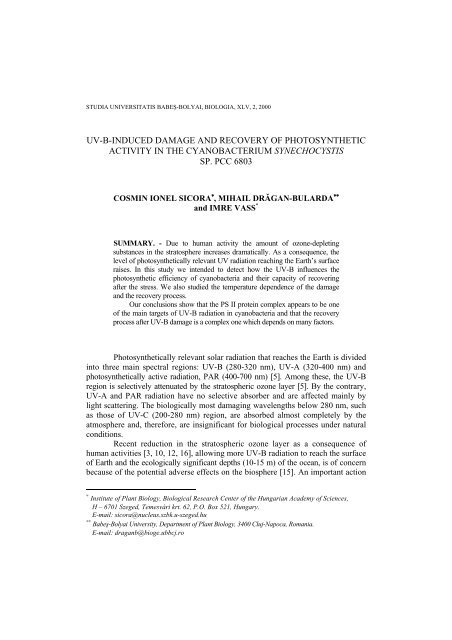studia universitatis babeÅ-bolyai biologia 2
studia universitatis babeÅ-bolyai biologia 2
studia universitatis babeÅ-bolyai biologia 2
Create successful ePaper yourself
Turn your PDF publications into a flip-book with our unique Google optimized e-Paper software.
STUDIA UNIVERSITATIS BABEŞ-BOLYAI, BIOLOGIA, XLV, 2, 2000<br />
UV-B-INDUCED DAMAGE AND RECOVERY OF PHOTOSYNTHETIC<br />
ACTIVITY IN THE CYANOBACTERIUM SYNECHOCYSTIS<br />
SP. PCC 6803<br />
COSMIN IONEL SICORA ∗ , MIHAIL DRĂGAN-BULARDA ∗∗<br />
and IMRE VASS *<br />
SUMMARY. - Due to human activity the amount of ozone-depleting<br />
substances in the stratosphere increases dramatically. As a consequence, the<br />
level of photosynthetically relevant UV radiation reaching the Earth’s surface<br />
raises. In this study we intended to detect how the UV-B influences the<br />
photosynthetic efficiency of cyanobacteria and their capacity of recovering<br />
after the stress. We also studied the temperature dependence of the damage<br />
and the recovery process.<br />
Our conclusions show that the PS II protein complex appears to be one<br />
of the main targets of UV-B radiation in cyanobacteria and that the recovery<br />
process after UV-B damage is a complex one which depends on many factors.<br />
Photosynthetically relevant solar radiation that reaches the Earth is divided<br />
into three main spectral regions: UV-B (280-320 nm), UV-A (320-400 nm) and<br />
photosynthetically active radiation, PAR (400-700 nm) [5]. Among these, the UV-B<br />
region is selectively attenuated by the stratospheric ozone layer [5]. By the contrary,<br />
UV-A and PAR radiation have no selective absorber and are affected mainly by<br />
light scattering. The biologically most damaging wavelengths below 280 nm, such<br />
as those of UV-C (200-280 nm) region, are absorbed almost completely by the<br />
atmosphere and, therefore, are insignificant for biological processes under natural<br />
conditions.<br />
Recent reduction in the stratospheric ozone layer as a consequence of<br />
human activities [3, 10, 12, 16], allowing more UV-B radiation to reach the surface<br />
of Earth and the ecologically significant depths (10-15 m) of the ocean, is of concern<br />
because of the potential adverse effects on the biosphere [15]. An important action<br />
∗ Institute of Plant Biology, Biological Research Center of the Hungarian Academy of Sciences,<br />
H – 6701 Szeged, Temesvári krt. 62, P.O. Box 521, Hungary.<br />
E-mail: sicora@nucleus.szbk.u-szeged.hu<br />
∗∗ Babeş-Bolyai University, Department of Plant Biology, 3400 Cluj-Napoca, Romania.<br />
E-mail: draganb@bioge.ubbcj.ro

















